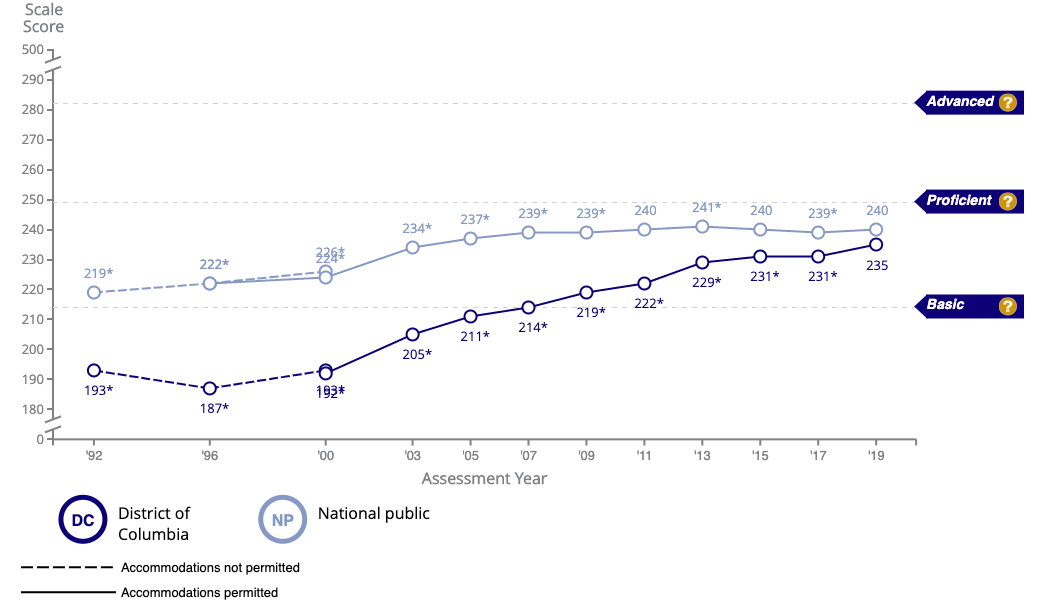|
NAEP is taken by only a representative - and random - sample of students, so NAEP is used more to assess the academic growth of the nation, state, or student group, rather than individual students. For this reason, there is currently no way to access individual student or school data.
If you want to know how your individual child is doing around the standards that your state has set – which for DC are the Common Core State Standards – then, you should make sure that your school gives you your child’s PARCC results (in grades 3-8 and once in high school for reading and math) that students take annually or the NWEA MAP scores that students take two or three times a year and can show you your child’s growth during that academic year.
|
|
How do I understand DC's Scores?
|
|
|
|
DC’s Fourth Grade Math Performance – Scale Score
|
 |
|
Achievement Levels
To help make sense of the scale scores and give a better understanding of what they mean, student achievement is categorized into three achievement levels set by the National Assessment Governing Board. The levels, Basic, Proficient, and Advanced measure what skills students should know and be able to do proficiently at each grade assessed.
|
|
|
DC’s Fourth Grade Math Performance – Achievement Levels
|
 |
|
Nationwide
NAEP is administered every two years, so our most recent comparison comes from 2017. Nationwide, results didn’t show much progress. In many cases, overall performance declined.
-
Gained 1 scale score point in fourth-grade math
-
1 scale score point decline in fourth-grade reading
-
1 scale score point decline in eighth-grade math
- 3 scale score point decline in eighth-grade reading
DC
DC saw statistically significant growth in three areas, and showed small - but statistically insignificant gains - in fourth grade reading. Check out OSSE’s presentation on the results here.
|
|
|
Overall, DC has made some of the largest gains in the last three decades since the test was first administered, compared to the other 50 states. In fourth grade math, DC has gained nearly 30 points since 2003.
|
|
|
While we should celebrate that growth, it is critical that we continue to focus on closing the gaps between DC students and students nationwide as well as the gaps we see across student groups. We cannot ignore the data that demonstrates the deep inequities in our system and that many parents and families experience first-hand every day. While DC students are closing the gap with their peers nationwide, scores are still behind in every subject. In DC, large differences between black and Hispanic students and their white peers persist (47 and 40 points, respectively), as well as gaps between students with disabilities and those without (38 points).
Furthermore, the analysis from our partners at EmpowerK12 shows scores have continued to increase for students who are economically disadvantaged. Still, at the current rate, students will close the gap with their wealthier national peers in 80 years – not nearly fast enough to do right by our kids.
|
|
|
We MUST take steps to accelerate this progress and set ALL students of all races, backgrounds, and income-levels up for success later in life. Every child is capable of achieving great things, it is our job to work together to unlock their potential and help them thrive!
|
|
|
We hope that our city’s education leaders work in partnership with families and communities to implement the solutions that THEY want to see. This means adequate and equitable resources for schools, transparent citywide school funding, and bold policies that allow parents to lead the charge towards #GreatSchoolsInEveryWard.
PAVE Parent Leaders are doing their part by advocating for increased access to specialized school programs and mental health supports and trauma-informed training in all schools. We can’t wait to see all they accomplish this year and the change they make for kids!
Check out what they’ve been up to here and reach out to [email protected] for more information about how YOU can get involved. We can only get to a more equitable and inclusive education system with all of us working together on behalf of each and every child in every ward and community – PAVE the way with us!
|
|
|
|